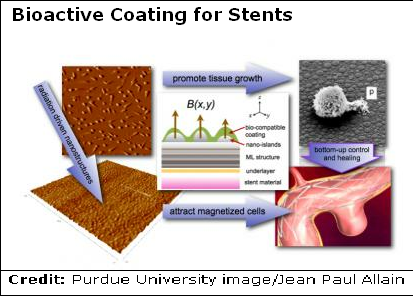The U.S. Army has provided a $1.5 million grant over a three-year period to fund research carried out by Purdue University in collaboration with neurosurgeons from Walter Reed National Military Medical Center in the area of brain treatment using nanotechnology.
 Bioactive Coating for Stents
Bioactive Coating for Stents
The research has yielded a bioactive coating for stents that can be used in the treatment of cerebral aneurism, especially aneurism, which is a result of head injury from bomb blasts. The research is spearheaded by Purdue University professor Jean Paul Allain and Lisa Reece. Allain, who is affiliated to Purdue University’s Birck Nanotechnology Center, is scheduled to speak before the U.S. Congress on May 24, 2012 on the potential of nanotechnology in treating brain injury. The talk coincides with the first Brain Mapping day.
Brain aneurism is a condition of weakness of the cerebral or artery wall which causes the blood vessels in that region to balloon. The survival rate in traditional treatment methods is only 50/50 as there is potential for formation of life threatening blood clots after surgery. There is also a high possibility of impairment in survivors. Typical treatment methods consist of either inserting a tube into the brain via an artery and implanting a metallic coil in the region of aneurism or performing surgery to clip the balloon like sac. The bioactive coated stents would transform the approach to aneurism treatment. The researchers have developed a regenerative approach in which the bioactive materials facilitate repair of damaged blood vessels by attracting cells. The stent is a non-magnetic metallic mesh of the likes of stainless steel and other alloys. It is coated with bioactive material at places to attract the magnetized cells. Ion beams are used to coat the stent a Purdue laboratory. Cell regeneration depends on the chemical composition and topology of the surface through which they send signals for regeneration. The irradiation process takes care of these two aspects. Efforts are also on to develop stents that would be displayed in medical imaging in order to gauge the ability of the bioactive coatings to do their work in the bloodstream.